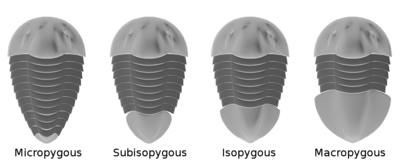
The pygidium (pl.: pygidia) is the posterior body part or shield of crustaceans and some other arthropods, such as insects and the extinct trilobites. In groups other than insects, it contains the anus and, in females, the ovipositor. It is composed of fused body segments, sometimes with a tail, and separated from thoracic segments by an articulation.[1]
YouTube Encyclopedic
-
1/3Views:65614 6013 244
-
Crotalocephalus sp. Trilobite - Object of the Month - Lapworth Museum of Geology
-
ANNELIDA GENERAL CHARECTER
-
Parapodia Lecture, BSc Biotechnology by Ms. Priyanka khan.
Transcription
My name's Katie, I work here at the Lapworth Museum as Assistant Curator. I'm here to talk to you today about a trilobite. Trilobites lived 525 to 250 million years ago. Like all arthropods they had an exoskelton made up of three distinct parts. The cephalon, which is the head here, and the segmented body which is the thorax and the pygidium or tail. So this was all to protect the soft body parts which you can see here. When trilobites first appeared in the rock record in the earliest Cambrian they already had this complex exoskeleton as well as the world's first complex visual system. They were very diverse and they had already diversified over a wide range of environments from shallow to deep water environments. The trilobite I'm going to talk to you about today is called Crotalocephalus. It was found in the Anti Atlas in the Morocco region and it's from the Devonian period so it's actually 415-400 million years old. As you can see it's got very well preserved pygidium and pleural spines which you can see just about here. These would have been used to protect it from predators as well as to stop it sinking into the soft sediment. So it's likely that it would have lived on the sea floor and its glabella here, which is on the cephalon, is likely to indicate that it would have been a predator and it would have collected prey. Trilobites as a species lived for over 275 million years. Over this time they did actually have a lot of extinction events to contend with. During the Devonian however their luck was coming to an end and the group was actually confined to just one order, which was the Proetida. So the order Proetida was restricted to shallow shelf environments. In the middle Permian unfortunately there was a major regression, which is a sea level fall, so this further restricted them to the environment and they couldn't survive when the end Permian mass extinction wiped out 95% of marine life so, unfortunately, the trilobites came to an end.
Chelicerates
In arachnids, the pygidium is formed by reduction of the last three opisthosomal segments to rings where there is no distinction between tergites and sternites. A pygidium is present in Palpigradi, Amblypygi, Uropygi, Schizomida, Ricinulei and in the extinct order Trigonotarbida. It is also present in early fossil representatives of horseshoe crabs.
Trilobites
In trilobites, the pygidium can range from extremely small (much smaller than the head, or cephalon) to larger than the cephalon. They can be smooth, as in order Asaphida, or spiny, as in order Lichida. They can be classified into four categories according to their relative size in comparison to the cephalon.[2]
- Micropygous – the pygidium is considerably smaller than the cephalon.
- Subisopygous – the pygidium is slightly smaller than the cephalon.
- Isopygous – the cephalon and the pygidium are more or less of equal size.
- Macropygous – the pygidium is larger than the cephalon.
They can further be subdivided in their morphological similarity to the thorax. Pygidia that are similar in shape and form to the thoracic segments are termed homonomous, while pygidia that vary significantly from the shape and form of the thoracic segments (like by the presence or absence of spines) are heteronomous.

Insects
In insects, the pygidium is the dorsal tergite of the last external abdominal segment.[3]
Other uses
Pygidium is also a superseded genus of fish of the family Trichomycteridae. Most species of this genus have been reassigned to the genus Trichomycterus.
See also
References
- ^ Shultz, J.W. (1990). Evolutionary Morphology And Phylogeny of Arachnida. Cladistics 6: 1–38.
- ^ Samuel M. Gon III (November 12, 2009). "The Pygidium". A Guide to the Orders of Trilobites. Retrieved April 13, 2011.
- ^ G. Gordh, D. Headrick. 2003. A Dictionary of Entomology. CABI Publishing. p. 757.


